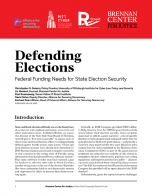
Brookings _Cybersecurity-Election-Interference
Online foreign influence efforts are a threat that is here to stay. At least 24 countries worldwide have been targeted, with Russia being by far the most active aggressor; but evidence suggests Iran, China, and Saudi Arabia are also engaging, notes Margaret L. Taylor, Senior Editor and Counsel for Lawfare. Social media companies like Twitter and Facebook are making some progress, but as Arya Goel, Diego Martin, and Jacob N. Shapiro point out, the best outcome is a “gradual marginalization by the combination of internet platform self-policing…and government actions that raise the expected costs for attackers.”
 European democracies have been coping with foreign interference for longer than the United States, and the primary threat to European democracies comes from Russia. The challenge for the United States is not only to learn from the past and the experiences of other countries but also anticipate and respond to emerging challenges, she writes for Brookings:
European democracies have been coping with foreign interference for longer than the United States, and the primary threat to European democracies comes from Russia. The challenge for the United States is not only to learn from the past and the experiences of other countries but also anticipate and respond to emerging challenges, she writes for Brookings:
The foreign interference threat is constantly changing. For example, Russian disinformation efforts in parts of Europe have become less overt over the past three years, and governments must adapt to protect against new forms of assault. The coming wave of disruptive technologies, like artificial intelligence and decentralized applications, will require new methods for responding to and disrupting disinformation campaigns.
 The key lesson from abroad is that disinformation is most effective when it plays on existing tensions within society, Taylor adds. Amplifying and exacerbating those tensions can be all that is needed to destabilize a democracy.
The key lesson from abroad is that disinformation is most effective when it plays on existing tensions within society, Taylor adds. Amplifying and exacerbating those tensions can be all that is needed to destabilize a democracy.
Katarína Klingová detects “A Ray of Hope in the Haze: Disinformation in the Slovak Presidential Election” in a post for the International Forum’s Power 3.0 Blog.







